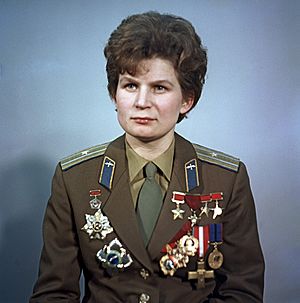Vostok 6 facts for kids

The Vostok 6 capsule in a museum display (2016)
|
|
| Operator | Soviet space program |
|---|---|
| Mission duration | 2 days, 22 hours, 50 minutes |
| Orbits completed | 48 |
| Spacecraft properties | |
| Spacecraft | Vostok-3KA No.8 |
| Manufacturer | Experimental Design Bureau OKB-1 |
| Launch mass | 4,713 kilograms (10,390 lb) |
| Crew | |
| Crew size | 1 |
| Members | Valentina Tereshkova |
| Callsign | Чайка (Chayka - "Seagull") |
| Start of mission | |
| Launch date | 16 June 1963, 09:29:52 UTC |
| Rocket | Vostok-K 8K72K |
| Launch site | Baikonur 1/5 |
| End of mission | |
| Landing date | 19 June 1963, 08:20 UTC |
| Landing site | 53°12′34″N 80°48′14″E / 53.209375°N 80.80395°E |
| Orbital parameters | |
| Reference system | Geocentric |
| Regime | Low Earth |
| Eccentricity | 0.00365 |
| Perigee | 164 kilometres (102 mi) |
| Apogee | 212 kilometres (132 mi) |
| Inclination | 65.09 degrees |
| Period | 88.25 minutes |
| Epoch | 16 June 1963, 05:36:00 UTC |
  Valentina Tereshkova, first female cosmonaut, Hero of the Soviet Union, 1969. Vostok program
Crewed flights |
|
Vostok 6 was a very important space mission. It was the first time a woman, Valentina Tereshkova, traveled into space. The name 'Vostok 6' means 'East 6' in Russian. This historic flight happened on June 16, 1963.
Contents
The Vostok 6 Mission
The Vostok 6 spacecraft launched smoothly on June 16, 1963. Scientists wanted to learn how a woman's body would react to being in space. During her trip, Valentina Tereshkova kept a flight diary. She also took many photos and even steered the spacecraft herself. Her pictures of Earth's horizon helped scientists understand more about the layers of air around our planet.
Vostok 6 was planned to fly at the same time as another mission, Vostok 5. Originally, there were plans for two women to fly into space together. However, the Vostok space program changed its plans. Vostok 6 ended up being the very last flight of this type of spacecraft.
The Vostok 6 capsule landed safely in Russia. Today, you can see the actual capsule at the RKK Energia Museum near Moscow. There's even a statue of Valentina Tereshkova at the landing site, celebrating her amazing journey.
What Happened During the Flight?
During her time in space, Valentina Tereshkova was shown live on Soviet television. People could see her from inside the capsule! She even talked to the leader of the Soviet Union, Nikita Khrushchev, over the radio.
After the flight, reports about her health were a bit unclear. Later, some official stories made it sound like her performance wasn't perfect. Tereshkova herself said she had some body aches. She also found her helmet headset uncomfortable. She even felt sick when she tried to eat, but she thought it was because of the food's taste, not how she felt physically. One funny thing was that they forgot to pack her a toothbrush!
An official history book from 1973 said her condition and performance were "fair" or "adequate."
The Landing
Like all previous Vostok flights, Valentina Tereshkova had to eject from her capsule before landing. This means she parachuted down to Earth separately from the spacecraft. She landed safely.
In 2004, it was shared that there was a small problem with the spacecraft's computer program. It almost made the ship go higher into space instead of coming down! Valentina Tereshkova noticed this on her first day. She told the spacecraft's main designer, Sergey Korolev. The flight team quickly gave her new information to put into the program so she could land correctly. Korolev asked her to keep this problem a secret, which she did for many years.
The Crew
- Main Pilot: Valentina Tereshkova – This was her only trip to space.
- Backup Pilot: Irina Solovyova
- Reserve Pilot: Valentina Ponomaryova
Mission Details
- Weight of Spacecraft: 4,713 kg (10,390 lb) (about the same as a large car)
- Highest Point in Orbit (Apogee): 231 km (144 mi) above Earth
- Lowest Point in Orbit (Perigee): 180 km (110 mi) above Earth
- Orbit Angle (Inclination): 64.9 degrees (this is how tilted its path was compared to the Earth's equator)
- Time to Orbit Earth (Period): 87.8 minutes (less than an hour and a half to go all the way around Earth!)
See also
 In Spanish: Vostok 6 para niños
In Spanish: Vostok 6 para niños

